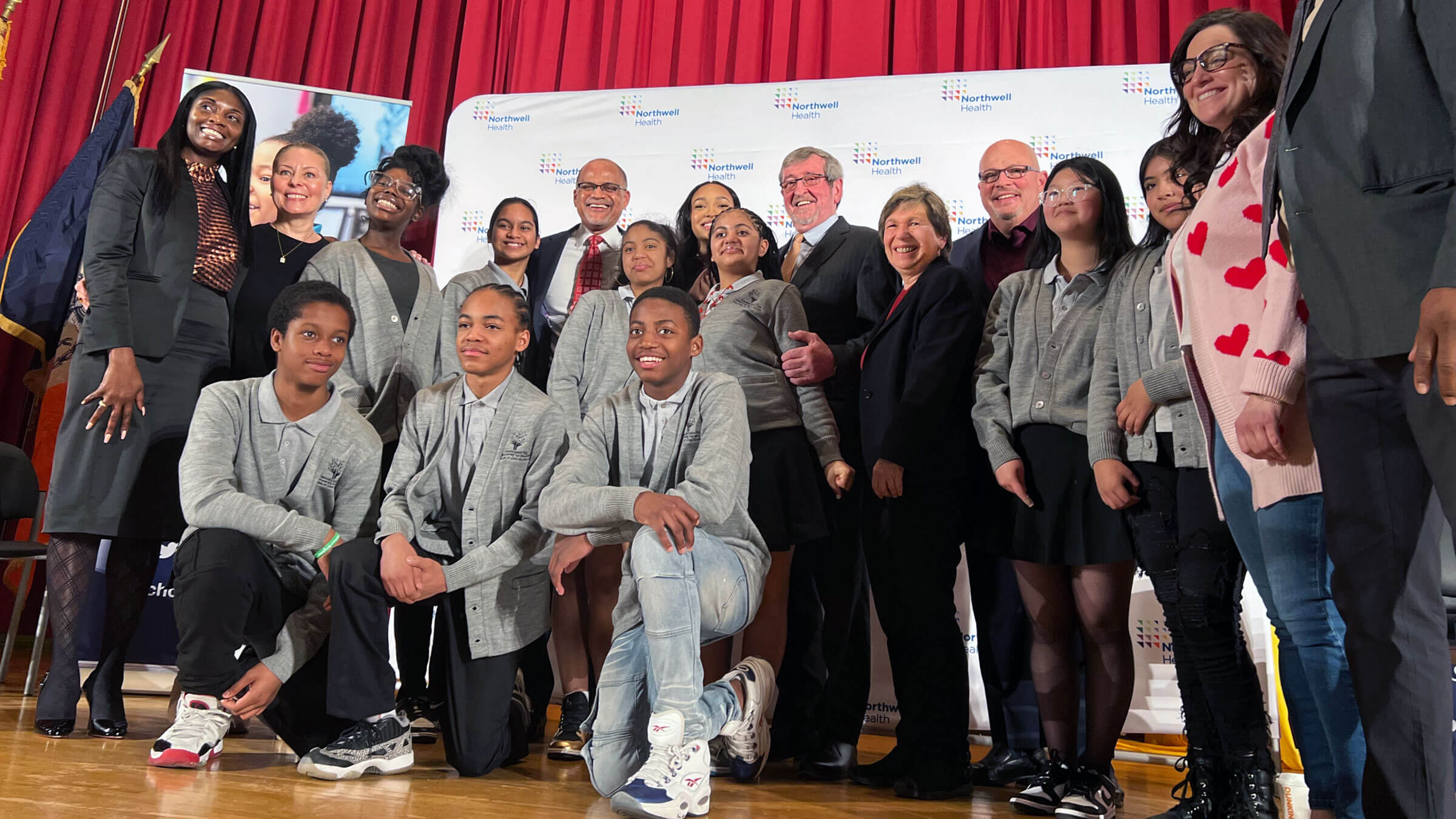Funding our future
School funding currently is not adequate to create equal opportunity for students from all backgrounds.

Weingarten at the announcement of a new health sciences high school in Queens, N.Y., on Feb. 14. Photo by Asher Huey
Money may not buy love or happiness, but it can provide a big bang for the buck in education. Research shows that targeting more money for education, especially for students from low-income families, increases student achievement and graduation rates and is linked to higher earnings and other positive life outcomes—all things to be pretty happy about.
In years past, when I and others advocated for higher pay for teachers and adequate and equitable education funding, the right wing would fire back, “money doesn’t matter.” But evidence matters, and I admire those willing to follow it, like researcher Eric Hanushek, who has made a stunning turnaround after arguing for decades that more funding didn’t lead to better educational outcomes. Hanushek has reviewed the most rigorous research on education funding and finds that money does, in fact, matter.
That is why we all should be concerned about the looming fiscal cliff when pandemic relief aid ends this fall. Schools received $190 billion in federal funding to help students recover from learning loss during the pandemic. Research by Harvard’s Thomas Kane and others shows that achievement gains from 2022 to 2023 were large relative both to historical trends and to what prior research would lead us to expect. Loss of that aid will equate to an average reduction in yearly spending of more than $1,000 per student. The cliff will be worse in districts serving high-need students.
In the United States, education is largely controlled by the states, including K-12 school financing. While many state leaders talk about the importance of education, they don’t walk the walk. A new report finds that 39 states devote a smaller share of their economies to their K-12 public schools than they did in 2006. “The Adequacy and Fairness of State School Finance Systems,” by researchers at the Albert Shanker Institute, the University of Miami and Rutgers University, estimates that this decrease in “fiscal effort” cost schools the equivalent of $360 billion in state and local funding between 2016 and 2021. Instead of restoring funding as states’ economies grew following the disastrous cuts to education during the Great Recession, 4 out of 5 states have not returned to the fiscal effort they were making to fund public schools in 2006.
“The reality is that it costs more to achieve higher educational outcomes,” noted Bruce Baker, one of the report’s authors. “And states are unlikely to see much return on their investments when they are not really making those investments.”
“Equal opportunity is the endgame in education policy,” says co-author Matthew Di Carlo. The key question, then, is whether funding is adequate for students from all backgrounds to achieve common outcome goals. The report found that every single state funds its affluent districts more adequately than higher-poverty districts that serve the most vulnerable students—creating opportunity gaps ranging from moderate to huge. Di Carlo notes that “states with large opportunity gaps are essentially inequality factories, with affluent districts funded to achieve higher student outcomes than lower-income districts. We cannot expect to close achievement gaps when states’ systems are designed to reproduce them.”
States must narrow these opportunity gaps by targeting additional state aid for higher-poverty districts, which have greater needs and less ability to meet those needs with local property tax revenue. Take one state, California, whose 2013 Local Control Funding Formula increased state support to schools by $18 billion over eight years after a history of low school funding. LCFF-induced increases in school spending significantly improved academic achievement and high school graduation rates, especially for poor and minority students.
This school finance report drives home a fact that I have seen firsthand in schools here and abroad: Public schools in the United States are among the most inequitably funded of any in the industrialized world. There have been countless times I have wished that lawmakers (as well as critics of public schools) could see what I see in well-resourced public schools—whether it’s cutting-edge career and technical education programs, impressive theater productions, or students engrossed in Socratic seminars. Just as often, I have wanted to shine a light on the tragic inequity in under-resourced schools that robs huge numbers of American children of the opportunities they deserve as much as any other child. These students have overcrowded classrooms, decrepit and unsafe school buildings, inadequate and outdated learning materials, and shortages of teachers, school nurses, counselors and librarians.
We often say in education that if kids can see it and touch it, they can be it. But first we must build it. The AFT is about real solutions that help create a better life and provide opportunity, but that doesn’t happen without resources spent wisely. I invite you to read this important report at www.schoolfinancedata.org for practical solutions we must ask lawmakers to enact so all our children have access to the great public schools they deserve.
A message from our Publisher & CEO Rachel Fishman Feddersen

I hope you appreciated this article. Before you go, I’d like to ask you to please support the Forward’s award-winning, nonprofit journalism during this critical time.
We’ve set a goal to raise $260,000 by December 31. That’s an ambitious goal, but one that will give us the resources we need to invest in the high quality news, opinion, analysis and cultural coverage that isn’t available anywhere else.
If you feel inspired to make an impact, now is the time to give something back. Join us as a member at your most generous level.
— Rachel Fishman Feddersen, Publisher and CEO















